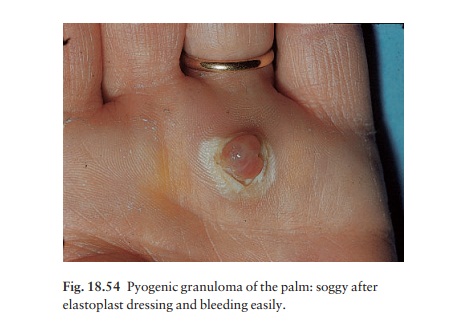Chapter: Clinical Dermatology: Skin tumours
Tumours of the dermis: Lymphangiomas

Lymphangiomas
The
most common type is lymphangioma circum-scriptum which appears as a cluster of
vesicles resem-bling frog spawn. If treatment is needed, excision has to be
wide and deep as dilatated lymphatic channels and cisterns extend to the
subcutaneous tissue.
Glomus tumours
These
are derived from the cells surrounding small arteriovenous shunts. Solitary
lesions are painful and most common on the extremities and under the nails.
Multiple lesions are seldom painful and may affect other parts of the body.
Painful lesions can be removed; others may be left.
Pyogenic granulomas
These
badly named lesions are in fact common benign acquired haemangiomas, often seen
in children and young adults. They develop at sites of trauma, over the course
of a few weeks, as bright red raised, some-times pedunculated and
raspberry-like lesions which bleed easily (Fig. 18.54).
The important differential diagnosis is from an amelanotic malignant melanoma and, for this reason, the histology should always be checked. A pyogenic granuloma shows leashes of vessels of varying calibre covered by a thin, often ulcerated, epidermis.

Lesions
should be removed by curettage under local anaesthetic with cautery to the
base. Rarely, this is followed by recurrence or an eruption of satellite
lesions around the original site.
Related Topics